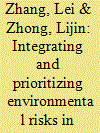|
|
|
Sort Order |
|
|
|
Items / Page
|
|
|
|
|
|
|
| Srl | Item |
| 1 |
ID:
136207


|
|
|
|
|
| Summary/Abstract |
Shale gas development in China can generate great potential economic benefits, but also poses serious environmental risks. In this paper, we offer a macro assessment of the environmental risks of shale gas development in China. We use the US experience to identify the nature of shale gas development activities and the types of potential burdens these activities may create. We then review the baseline environmental conditions and the effectiveness of environmental regulations in China and discuss the implications of these China-specific factors for risk assessment. We recommend China to conduct a strategic environmental assessment and to consider sector-specific environmental regulations.
|
|
|
|
|
|
|
|
|
|
|
|
|
|
|
|
| 2 |
ID:
095833


|
|
|
|
|
| Publication |
2010.
|
| Summary/Abstract |
Human society faces a growing number of risks, including both natural disasters and risks that stem from human behavior. This is particularly true in China, which is experiencing rapid social, economic and political transitions. Since the 1970s, China's modernization process has been accompanied by the emergence of an increasing number of man-made risks, in particular environmental pollution, but until very recently, a risk management system did not exist in China. Society was woken up by a series of disasters and accidents, including SARS in 2003, followed by the explosion of avian flu and the chemical spill in the Songhua River in 2005. The last incident in particular finally kicked off the development of a national risk management system (specifically an emergency response system) in China. This paper analyses the status quo of the legislation, institutions and mechanisms for risk management in China and identifies opportunities and strategies for prioritizing and integrating environmental and health risks into the emerging system. The study concludes that although a series of alarming incidents have succeeded in putting risk management issues at the top of the public and political agenda, currently risk management in China can be characterized as reactive and compartmentalized, with a lack of prioritization and integration of policy efforts and resources. There is also a danger that the traditional state-centered approach may fail to create an effective risk management system, which requires improved transparency, accountability, and cross-sectoral coordination. The paper concludes with the proposal of strategies that might enable the environmental authorities to be more effective and reduce their marginalization and isolation.
|
|
|
|
|
|
|
|
|
|
|
|
|
|
|
|
| 3 |
ID:
132683


|
|
|
|
|
| Publication |
2014.
|
| Summary/Abstract |
The deepwater horizon accident may have shaken the sustainability ratings and indices credibility, but it also reinforced their importance. The objective of this article is to contribute to the improvement of corporate sustainability valuations by investigating if reserves profiles can affect the environmental risk exposure of an Oil & Gas (O&G) corporation. Data on reserves from 2009 to 2012 of 24 listed O&G companies were used to test six hypotheses, addressing how these profiles could relate to the four material environmental risks: climate change, accidents, sensitive area/access, water. The frequency with which companies reported these risks was evaluated using key word in context (KWIC) content analysis. Analysis of variance (Anova) and Student×s t tests were applied to each of the hypotheses. This study shows environmental risks are embedded with the oil and gas reserves. We found the following relationships: (1) companies with heavy oil reserves report more exposure to climate change risks, particularly emissions control; (2) water is more of an issue with companies with higher bitumen and natural gas reserves; and (3) there is significant regional bias in the reporting of the environmental risk factors. These findings have broad implications for the financial industry, governments, investors and lenders alike.
|
|
|
|
|
|
|
|
|
|
|
|
|
|
|
|
| 4 |
ID:
129922


|
|
|
|
|
|
|
|